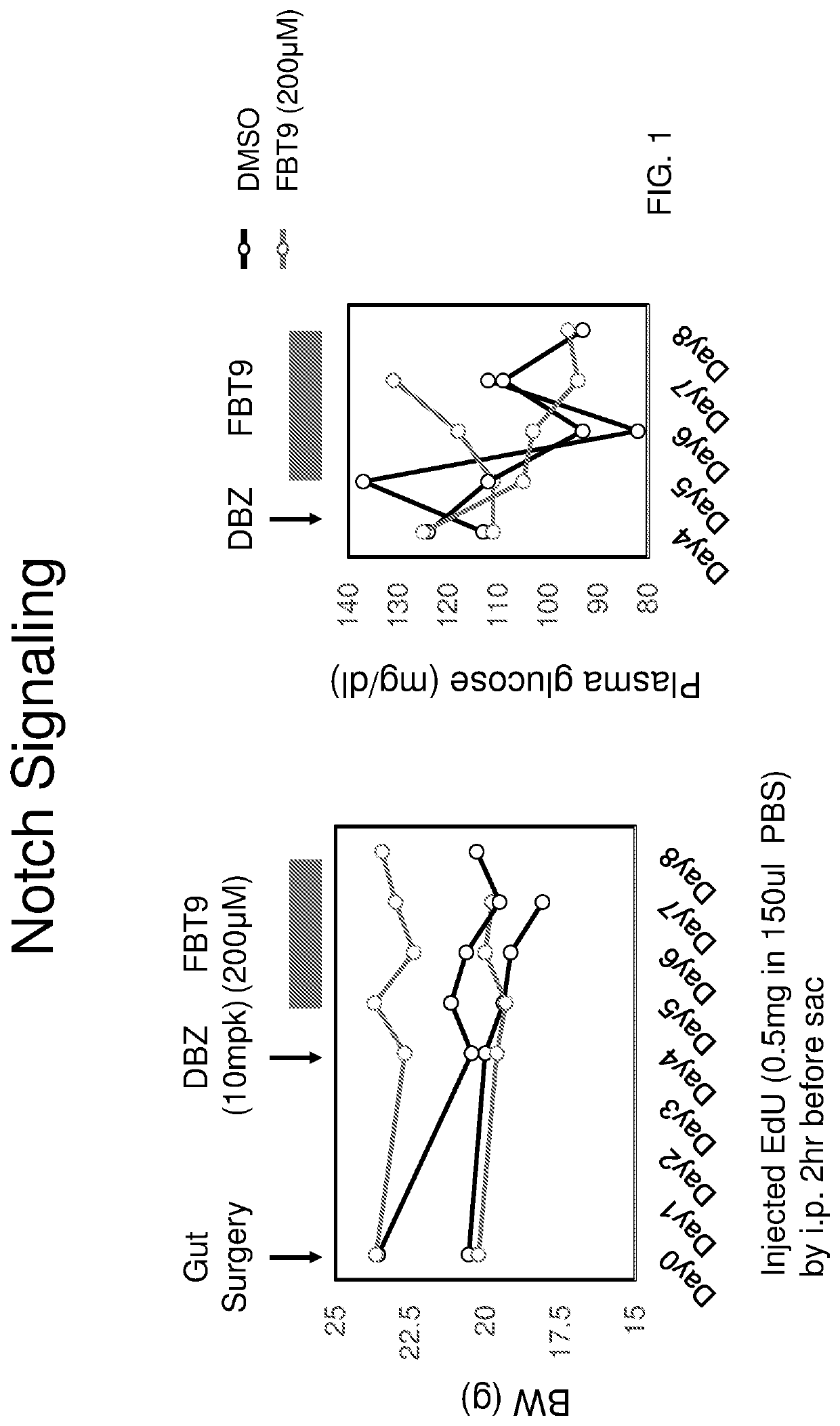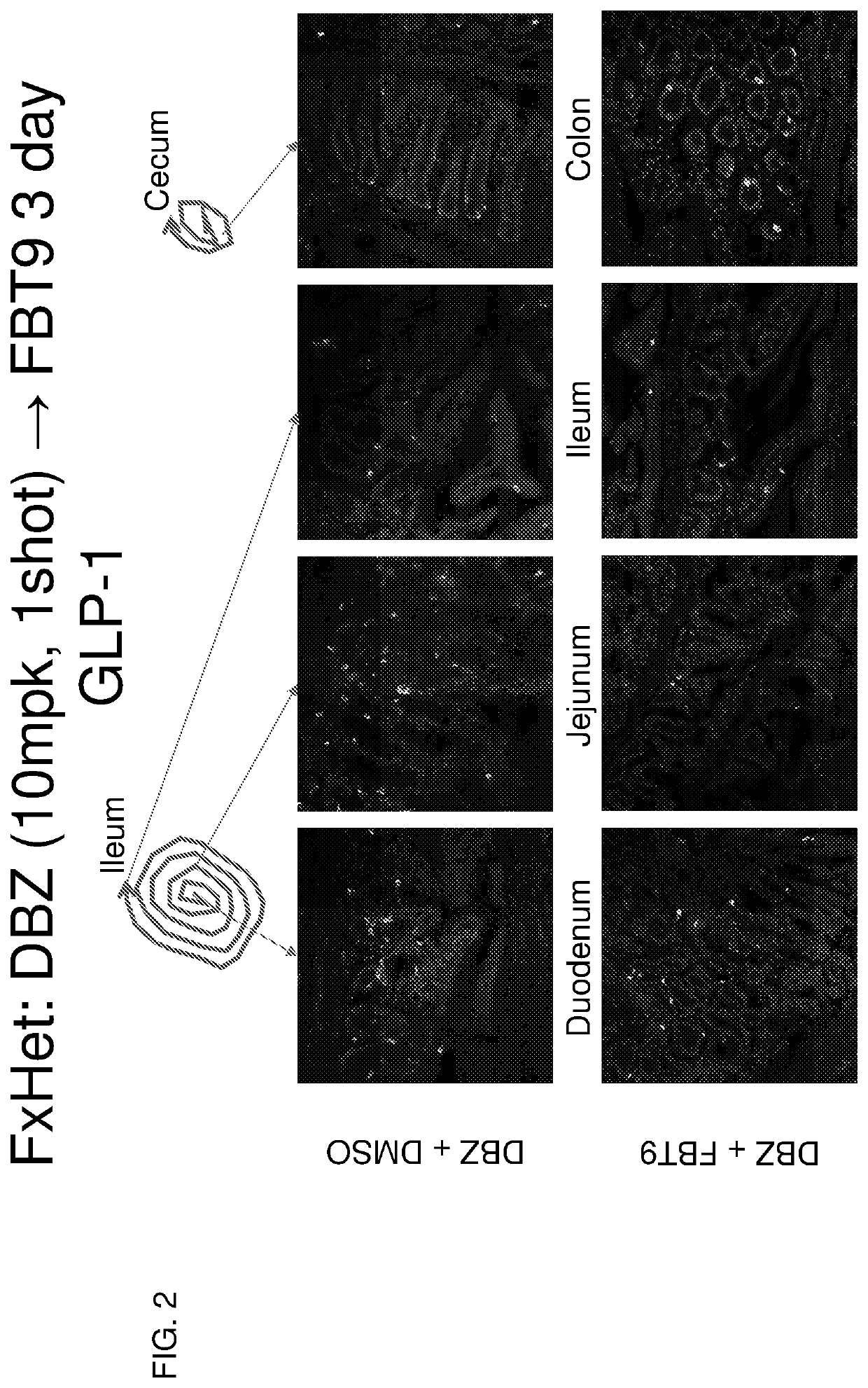Co-Administration of inhibitors to produce insulin producing gut cells
a technology of inhibitors and gut cells, which is applied in the direction of drug compositions, heterocyclic compound active ingredients, and metabolic disorders, etc., can solve the problems of impaired glucose metabolism with attendant complications, insufficient insulin production, and insufficient insulin production
- Summary
- Abstract
- Description
- Claims
- Application Information
AI Technical Summary
Benefits of technology
Problems solved by technology
Method used
Image
Examples
example 1
stration of Foxo1 Inhibitor (Compound 9) and Notch Inhibitor (DBZ)
[0200]The experiment consisted of performing surgery on 8-week-old mice to implant an enterojejujnal catheter to deliver drugs locally to the intestinal mucosa. After a 1-week recovery period, mice were treated with a single i.p. injection of DBZ or vehicle control. Administration of Foxo1 inhibitor compound 9 (Langlet et al. 2017 Cell, see below)
was initiated either on the same day or on the following day, t.i.d. by injection via enterojejunal catheter for 3 days. At the end of the experiment, mice were sacrificed and the intestine analyzed for enteroendocrine cell content using immunohistochemistry. The results of these experiments are provided in FIGS. 1-14. FIG. 7 shows that insulin-positive cells were generated by initial DBZ treatment and subsequent FBT9 treatment. FIG. 10 shows that the number of insulin-positive cells in the gut increased ˜5 fold over the treatment of FIG. 7. The treatment regime of FIG. 10 in...
example 2
ation of ROCK Inhibitor in Foxo1 Knockout Mice
[0201]The experiment consisted of treating 8-week-old mice (Foxo1 knockout mice) by oral gavage dosing of Y-27632, q.d., for 2 days. On day 3, mice were sacrificed and the intestine analyzed for enteroendocrine cell content using immunohistochemistry. The results of these experiments are provided in FIGS. 15-17. The arrows in FIGS. 15 and 16 represent c-peptide and insulin-positive cells, which resemble true beta-like cells. FIG. 17 shows that the amount of insulin-positive cells decreases dramatically without treatment with ROCK inhibitor.
example 3
ation of Foxo1 Inhibitor (Compound 10, “FBT10”) in Mouse Gut Organoid
[0202]Mouse gut organoid from a wild type mouse was treated with FBT10 (Compound 10, Langlet et al. 2017 Cell, see below).
After 72 hrs of treatment, some of the cells turned into insulin and serotonin (5HT) positive cells confirmed by immunohistochemistry (see FIG. 18). This data demonstrates that FBT10 is capable of generating insulin-positive cells from gut cells.
PUM
| Property | Measurement | Unit |
|---|---|---|
| concentrations | aaaaa | aaaaa |
| concentration | aaaaa | aaaaa |
| concentration | aaaaa | aaaaa |
Abstract
Description
Claims
Application Information
 Login to View More
Login to View More - R&D
- Intellectual Property
- Life Sciences
- Materials
- Tech Scout
- Unparalleled Data Quality
- Higher Quality Content
- 60% Fewer Hallucinations
Browse by: Latest US Patents, China's latest patents, Technical Efficacy Thesaurus, Application Domain, Technology Topic, Popular Technical Reports.
© 2025 PatSnap. All rights reserved.Legal|Privacy policy|Modern Slavery Act Transparency Statement|Sitemap|About US| Contact US: help@patsnap.com



